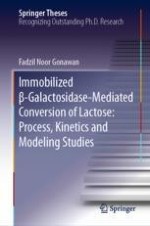2019 | Buch
Über dieses Buch
This book describes the reaction rate profiles of the β-galactosidase-catalyzed conversion of lactose on the inner surface of a hollow fiber membrane, which is employed as an enzymatic reactor system. The reaction rate profiles were obtained by solving the mass transfer and kinetics of reaction in a 2-dimensional model of the system. The primary challenge of this research was to develop the kinetic model of the reaction to describe the kinetic behavior as the reaction occurred on the membrane surface. Despite the difficulties, the proposed model can reliably replicate the actual process, as validation procedures have confirmed.
The reaction rates obtained analyze the performance of the immobilized enzyme on the membrane surface. Previously, an increase in performance of 'β-galactosidase-catalyzed conversion of lactose assisted by ultrafiltration was suggested due to inhibitor removal. However, as the analysis presented here shows, the concentration profile of the substrate on the membrane surface also affects the reaction performance.
Anzeige
